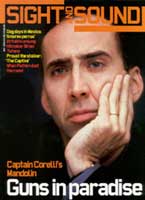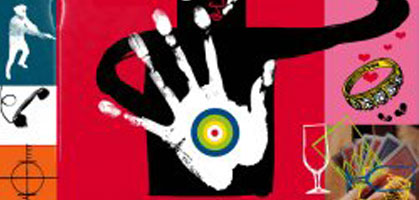
Critical Reading

Illustration by Brett Ryder
What can Hollywood's ever-present scandals tell us about the faultlines in American society, asks Michael Eaton
- Headline Hollywood: A Century of Film Scandal
- Edited by Adrienne L. McLean and David A. Cook,
- Rutgers UP, 313pp, $22
- ISBN 0 8135 2886 0
The recent break-up of moviedom's erstwhile perfect couple, Tom Cruise and Nicole Kidman, led to carefully phrased effusions in the press, recycling a heap of hearsay which had been trundling around the block for so long it was already well due for a service. These reports, as you must know, coalesce around either the male star's sexuality or his religion. The patent airing of such'secrets' may have contributed greatly to public gaiety and momentarily confirmed us more earthbound mortals in the security of our own peculiar realities in which nobody but ourselves seems much interested. All this, however - and I cannot stress it too strongly - is simply rumour, unlikely to affect either the careers of the protagonists or the wallets of their libel lawyers. Rumour remains a scandal that hasn't yet happened.
We all love a good scandal - unless we're its target. From its earliest days, "Hollywood", as Leo Rosten is quoted as saying in Headline Hollywood", as a symbol for sin... [has been] a scapegoat for the traditional hostilities, the embodiment of Bohemia to all the Philistines on the face of the globe." Though some might consider that the real and continuing reproaches of the movie business are best sought in industrial-relations practice, the press and public get juiced up when "an offense involving an Artist's moral turpitude" (as the standard 'morality clause' was worded) comes unexpectedly to light. As Sam Stoloff's article makes clear, the acquittal of comedian Fatty Arbuckle, then the industry's highest-paid star, following the death of wannabe starlet Virginia Rappe in 1921, with all the attendant innuendo about broken bottles (so luridly described in Kenneth Anger's book Hollywood Babylon), was paradoxically an economic godsend for the emerging studio system as the subsequent establishment of the Hays Office allowed the bosses to "flaunt their dictatorial, monopolistic control of labor markets under the guise of'cleaning house".
Etymologically, 'rumour' is merely a noise while 'scandal' derives from a word meaning a snare, a stumbling block laid for an enemy, where malice is inherently involved. The term further implies a revelation: information is uncovered which the accused person would rather had been kept under wraps and which will drastically affect a carefully cultivated reputation for the worse, if not entirely destroy it. So scandal is inseparable from both hypocrisy and authenticity - there's a lack of fit between what the apparent perpetrator publicly asserts he or she is and what he or she turns out to have been.
Of course, this malicious 'revelation' may not be true. This ugly rumour might be merely the outcome of gossip - another word with an interesting etymology. The 'god-sib' was originally a sponsor at a baptism, a name-giver at a rite of passage, someone who stood in a socially sanctioned role of protection before the term mutated into a person who took delight in peddling innuendo. For the forces of authority, gossip is always 'idle', while accusation is 'judicial'. In pre-literate, pre-industrial societies, gossip, it seems, operated as a domestic policing mechanism, a social speed-trap to put a brake on an individual's attempts to overtake appropriate social norms; it might even be regarded as a necessary means to curtail full scandal - open to the gaze of all - before its transgressive eruption caused irrevocable disgrace.
A scandal is structured like a detective story: it's a temporal process involving a private act, a subsequent cover-up, an eventual disclosure and the public consequences thereof. It's also reminiscent of a psychodrama, involving a fractured relationship between accuser and accused played out within the rules and roles of a specific community. However, just as ritual activities in 'organic societies' have metamorphosed into leisure pursuits in 'complex societies' (a shift from "the Liminal" to "the Liminoid", to use Victor Turner's evocative terms in From Ritual to Theatre) so have the dynamics of rumour, gossip and scandal moved away from the management of ourselves by our neighbours towards the humiliation by the mass media of more stellar bodies with our non-participatory selves as slavering witnesses. Scandal has become a function of celebrity - a concomitant displacement, perhaps, from 'the Factual' to'the Factoid'.
The first mass-consumed celebrity scandal in the English-speaking world, we learn in Headline Hollywood, was the outing of Lord Byron as the incestuous lover of his half-sister - the whistle-blower in this instance being the somewhat unlikely person of Harriet Beecher Stowe. It's hard to imagine a literary figure today causing too much of an uproar (though we might speculate that some fundamentalists might even now believe that J. K. Rowling must have made an infernal pact for fame and fortune in return for poisoning impressionable minds with Luciferian propaganda). No, Big Scandal needs Big Power, and these days that resides in the politics and entertainment industries.
And that's where this collection of essays comes in - not a breathless catalogue of salacious impropriety à la Hollywood Babylon (this reader, I'm afraid, often wished for Anger's unreliable, indispensable prose style), but a sober, academic attempt to contribute to the theory, no less, of movie scandals concerning sex, drugs, race and politics.
And this is the first problem, for though the calumnies on parade each expose a pertinent societal faultline, the subjects chosen aren't always easily comparable. Can there be any real equation, for instance, between the closure of the Actors' Lab (written about here by Cynthia Baron), which deprived dedicated professionals of a voice, a reputation and a livelihood, and the mismatch in press reactions to Rita Hayworth snuggling up to Aly Khan and Ingrid Bergman running off with Roberto Rossellini (as outlined by Adrienne L. McLean)? It's not that the latter study is in any way uninteresting as it convincingly demonstrates how the brouhaha following Bergman's betrayal of conventional morality was much less univocal than conventional wisdom has suggested. It's just that a symptom of the state's rabid but systematic attack on all manifestations of progressive thought and practice in post-war America seems to be of a different order of reality than a footnote to the history of the representation of cinematic stardom.
The second difficulty is that though the essays are organised chronologically, the collection fails as history because the focus of the contributions is necessarily different. Some (like Lucy Fischer's study of Hedy Lamarr and Ecstasy) rely almost exclusively on filmic textual analysis while others (like Peter Lehman and William Luhr's consideration of Blake Edwards) complicate a reading of their subject's films with hoary old chestnuts like the notion that Julie Andrews' husband isn't all he claims to be between the sheets. Some (like Susan McLeland's discussion of Jane Fonda's protean persona) lean almost exclusively upon media coverage of the star in question, to no great illuminative effect - does this tell us about a society or only its press? Others, however, do interrogate press material to illustrate entirely surprising aspects of a culture (Erik Hedling discusses reactions to the Bergman affair in the actress' home town, demonstrating that Swedish intellectual gate-keepers cared little about Ingrid's carnal shenanigans but were shocked by what was seen as her artistic sell-out to commercial hucksterism, as exemplified by the maker of Paisà!).
Overall, one might say the volume suffers from too much media studies and not nearly enough anthropology. I especially want to know about the members of'religious groups' and women's organisations' whose lives seem to gain social significance only when they're picketing picture theatres and boycotting movies by overpaid transgressive role models while the rest of us sit inside fantasising or at home writing gushing, supportive fan letters to our false idols. If the ephemeral outpourings of parasitic hacks are to be considered source material of theoretical value, then perhaps a greater concentration on the semiotics of the scandal sheets rather than simply their contents might be more to the point. In Mary Desjardins' essay on Confidential magazine in the 50s, one poorly reproduced photograph and a few tantalising quotes suggest that rumour, gossip and scandal operate through aesthetic construction.
The essays I found most fascinating both concern incidents from cinema's early days that turn on questions of authenticity. The first is Lee Grieveson's piece on the murder in 1906 of Stanford White, the architect, by Harry K. Thaw, the socialite, in purported revenge for the former's treatment of the latter's wife Evelyn Nesbit, the chorus girl, and Thaw's subsequent acquittal on the grounds of dementia Americana, a form of temporary insanity allowing a husband to murder in defence of the sanctity of holy matrimony (a central strand in E. L. Doctorow's novel Ragtime). A film, The Unwritten Law, subtitled A Thrilling Drama Based on [my emphasis] the Thaw-White Case, became the focus of debates about what should and shouldn't be portrayed as entertainment for the mass audience. As someone who is associated with'factual drama' and is currently yet again caught up in a storm in an eggcup over the dramatisation of an equally fascinating murder case which illuminates an aspect of the world we live in, I find the similarity in moral outrage and legal issues fascinating.
The most tragic instance in the volume, however, is to be found in Nancy Cook's fine and complex account of the circumstances surrounding a film made in the late 20s, The Silent Enemy, in which "Real Indians" enacted for the cameras an already destroyed way of life. One of the stars was Chief Buffalo Child Long Lance, who had served honourably in World War I and had been taken up by the smart set as the ideal, mythic, full-blooded representative of the vanished American. An older member of the cast, Yellow Robe, a Sioux, began to have suspicions about Long Lance's account of himself since he didn't seem to act like"a proper Indian": "he was too punctual, too jolly; and he talked too much." (Evidently Yellow Robe wasn't immune from stereotypical notions as to how his people were supposed to behave.)
On examination it was discovered that Long Lance's racial background was far from 'pure' and that his 'mixed blood' with its "unsettling miscegenational connotations "would classify him as 'colored'. Though Native Americans in Westerns have been portrayed by every cultural group under the sun, this revelation of the star's 'fraud' severely punctured the film's claims of authenticity and its leading actor died in obscurity two years later. This is an authentic scandal as it exposes an institutionalised racism at the heart of US society far more corrupting than any masquerade Sylvester Long of Winston-Salem, aka Chief Long Lance of the Blackfoot, might have perpetrated in order to accommodate himself to its pervasive rottenness.
Finally, though, we can perhaps take some small comfort in the fact that the bluenose wowsers who perpetually go to war against films and actors that transgress their absolute moral values also end up forgotten. Who would now remember Senator Edwin Johnson of Colorado if this book hadn't re-evoked his attempts to make a career out of calumniation? It was he who labelled Rossellini both a "communist" and an "infamous Nazi collaborator... a ruthless, blood-sucking, black-market operator... an associate of dope smugglers... a bedroom prowler", and his wife-to-be an "apostle of degradation". But we still have Stromboli and Voyage to Italy.
